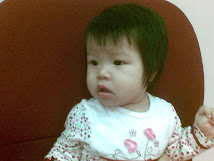Dad just watched a very intriguing Japanese video 'A Child's Creativity'.
http://www.youtube.com/watch?v=DcmnHFaevYkDaddy highly recommends this to parents (and teachers too) who think that they should teach their kids how to contain their wild thoughts (as if they can). Its great to have rational thinking, logical thoughts or even critical thinking... YES fantastic-
its all good ...AND it helps to understand that our mental operations (especially us children) are active and dynamic, rather then reactive and static.
The video in youtube just shows that adult's perceptions,
at times (or should it be most of the time), tend to be too prescriptive, and narrowly-focussed. Dad thought that the teacher started with an excellent question, "Draw whatever you want to..." but in the end, the teacher was not able to manage the ambigiuity of her own open question. Hurson (2008) reasoned that
"Staying in the question means being okay with the ambiguous. Being okay with the ambiguity means being open to the possible." (p.56) The video just blew dad's mind away with brainstorming rule #1:
Defer Judgement.
Building on Dad's earlier thoughts on the complexity of creativity, he learnt too from research that outstanding creative talents have imaginary companions and imaginary worlds (the latter known as paracosms). (Runco, 2007, p.57)
"During the preschool years, many children create imaginary companions that become a regular part of their daily routines" (Taylor et al., 1993, p.276). Mackeith (1982) and Taylor (1999) observd that imaginary companions and paracosms was most common in preschool. Singer and Singer (1992, p.110) noted though that the same "congnitive and emotional processes continued throughout life" (Runco, 2007, p.57).
Views of imaginary companions were even linked to psychoanalytic (Sperling, 1954), explained as sign of giftedness, indicative of narcissism, etc. Essentially, the imaginary companion may be indicative of
creative potential and the the the creation is the result of
creative process.
"In this light the imaginary companion provides the child with a great deal of practice at thinking creatively." (p.58)
The video also shed clarity to Runco' accusation of how parents and teachers hinder a child's cognitive development:
a)
Parents read this-
"Parents do not always tolerate creativity, it does often require tolerance. It is one thing to agree that creativity is a desirable thing, and a trait that you admire and want to encourage you in your children, but another thing to actually tolerate and support it. Brown's (in press) research on parents and children's language demonstrates the difficulties: He found that what was most important for parents in children's language was not grammer or complexity, but truthfulness. Parents did not want a child talking in a manner that reflected an inaccurate world view, and this is precisely what a creative child may supply!"
b) Teachers read this -
"Teachers also have difficulties with creative children. Consider in this
regard the profiles of 'the ideal child' provided by Torrance (1968) and Raina
(1975). Ideal children are polite, considerate, respectful, and
punctual. They are not unconventional, nonconforming, contrarians. (p.59)"
Dad will never forget his imaginary friends. He remember when he was Secondary Two (14 yrs) he dreamt that he was in his school's (ACS) clock tour in Barker Rd. Suddenly, he was chased by a giant size spider in his school hall. As he was hiding and running around away from the monster shooting it with his water gun, Wonder woman (yes, in her bright blue wonder bra) came to dad's rescue and saved him in her invincible fighter plane. Finally, she kissed Dad good bye and dropped him off on Sentosa. Now, Dad is quite a visionary actually. When Dad was 14, MRT (trains) were still unheard of in Singapore. Yet, he dreamt that by plucking himself on a track, he could assemble his own MRT carriage and with a GPS system (then unheard off again) he zoomed his way around town and easily folded up his own train. Cool ya....
So Dad would constantly probe us as we grow up to dream big and wild.... real wild? I wonder at 14, if Dad had dreamt if Wonder woman's wonder bra was invinsible too? hee hee... (we won't tell mum!)
References
Brown, J. W. (in press). Commentary to: Vandervert et al. Working Memory, Cerebellum and Creativity. Creativity Research Journal.
Hurson, T. (2008). Think better: An innovator's guide to productive thinking. New York: The McGraw Hill Companies.
Mackeith, S. A. (1982). Paracosms and the development of fantasy in childhood. Imagination, Cognition and Personality, 2, 261-267.
Runco, M. A. (2007). Creativity-Theories and themes: Research, development, and practice. San Diego, CA: Academic Press.
Singer, D. G., & Singer, J. L. (1992). The house of make-believe: Children's play and the developing imagination. Cambridge, MA: Harvard University Press.
Sperling, O. E. (1954). An imaginary companion, representing a prestage of the superego. Psychoanalytic Study of the Child, 9, 252-258.
Taylor, M. (1999). Imaginary companions and the children who create them. New York: Oxford University Press.
Taylor, M., Cartwright, B. S., & Carlson, S. M. (1993). A developmental investigation of children's imaginary companions. Developmental Psychology, 29, 276-285.





.jpg)
